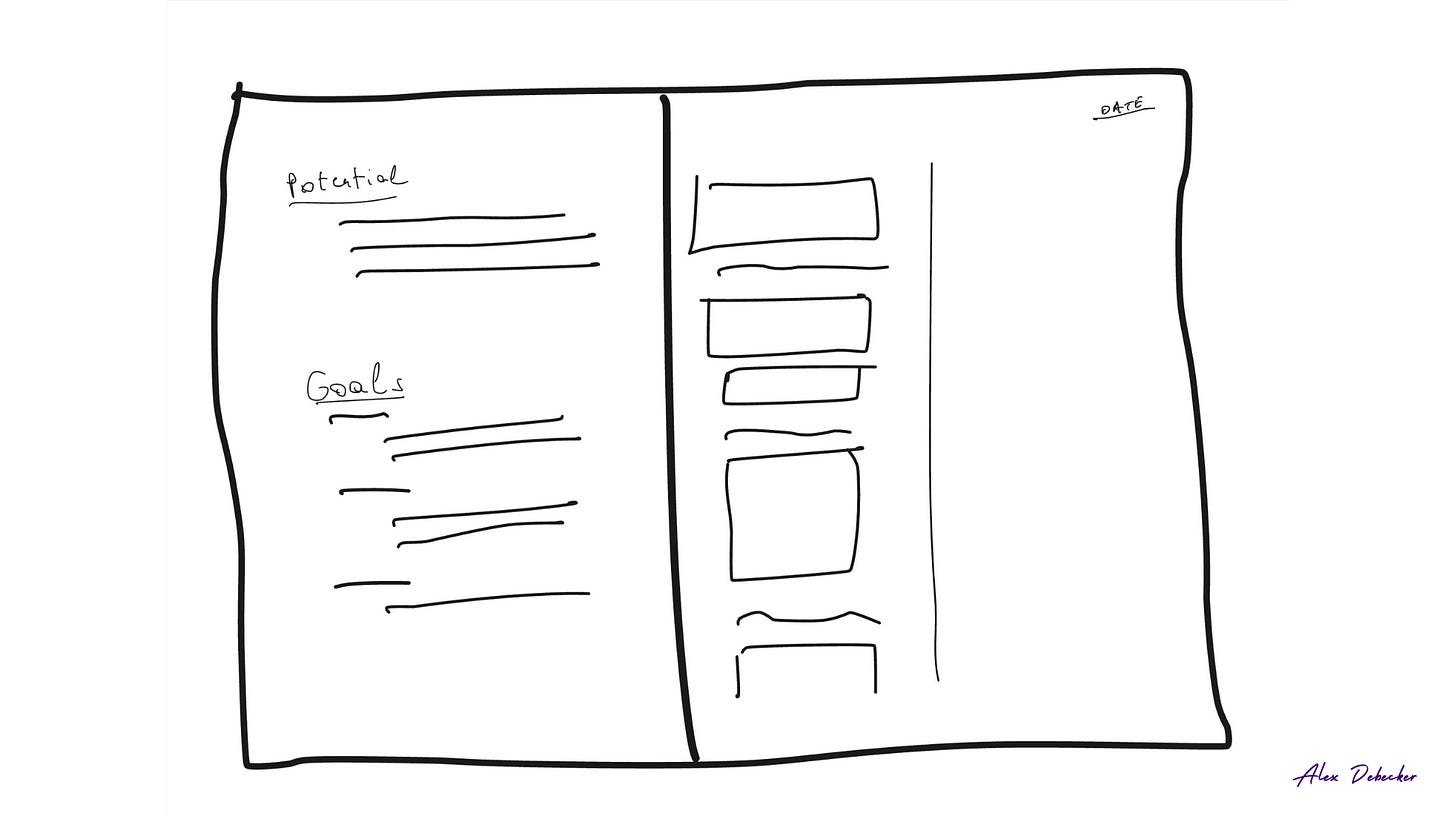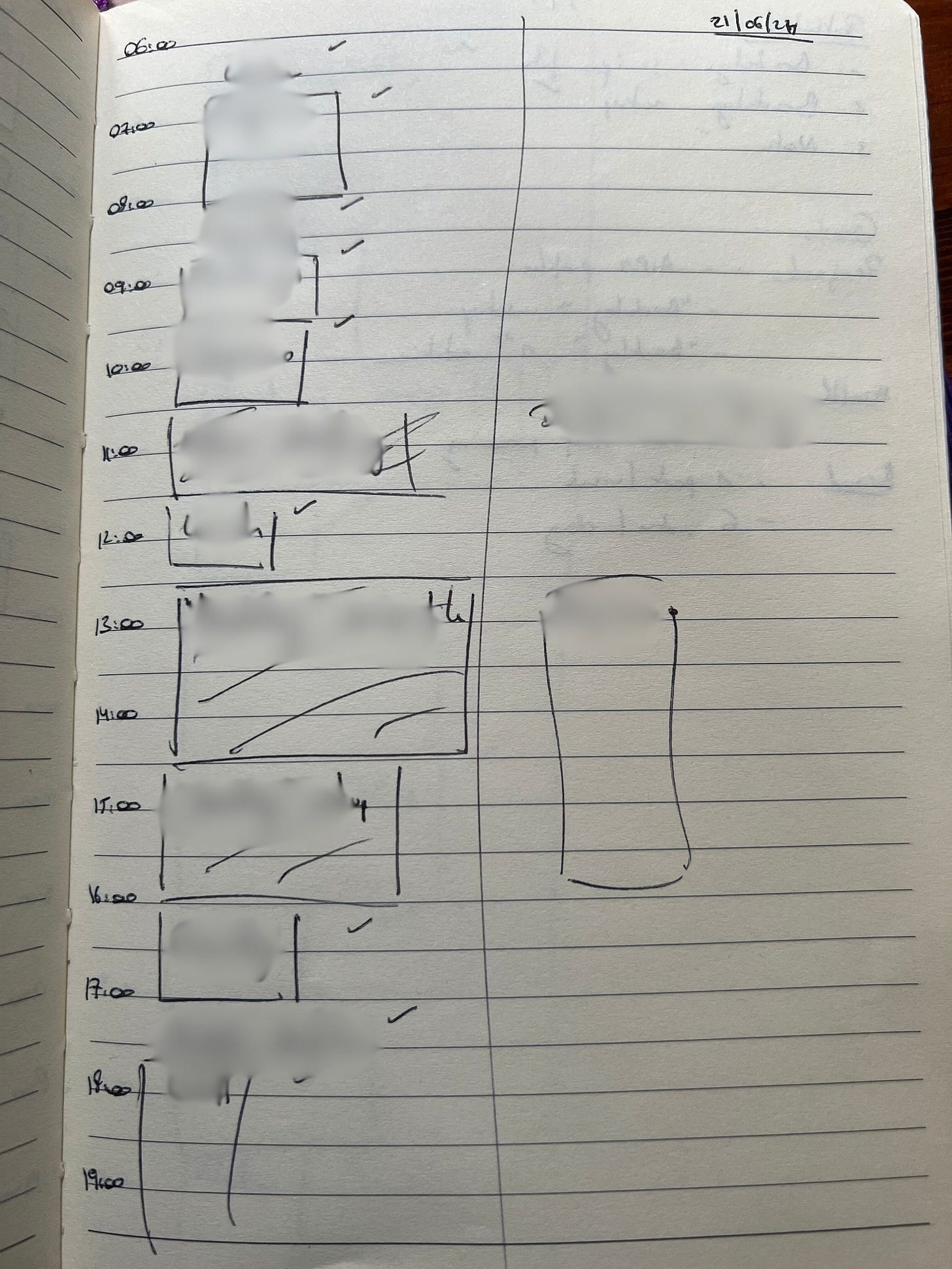Timeboxing: How I get (the right) sh*t done
I've tested plenty of productivity methods and 'hacks' over the years.
None ever stuck.
Sure, I sometimes get a quick boost for a couple of weeks. But soon the novelty wears off and I'm back at square one.
Then, I found something that worked.
For about a year now, I've gotten incredible results both in my work and personal life using the timeboxing method below. I even made it my ‘Productivity Hack of the Year’.
It took months of fine-tuning to make it work for me. Steal this method, but please make it your own.
What is timeboxing?
Timeboxing is a time management method.
Timeboxing is the exercise of plotting your tasks on your calendar. Each task is assigned to a start and end time. It is meant to increase productivity by:
Forcing you to assign a start time for each task, rather than creating a random cluster of ‘to-dos’.
Forcing you to limit the time you'll spend on the task to get it done (See: Parkinson’s Law).
My timeboxing method
It took me ~3 months of trial and error to turn the basic methodology above into something that would work for me.
Below is a granular breakdown of the method I refined and now use as a product manager and in my private life.
Step 1: Monthly goals
Timeboxing for me is not simply about how to work. It’s also about what to work on.
Before we dive into the daily routine, it’s important we set monthly (and yearly) goals; something to work towards each day.
At the start of each month, I write my goals. I break them into three categories: 'Work', 'Health', and ‘Projects’.
I aim to have a maximum of three goals per category per month. To improve productivity, work on the things that matter. Most of the time, this means limiting the things to work on.
I log my goals and, at the end of the month, I review them. Then I start again.
Step 2: Daily timeboxing routine
Each morning, I pick up my physical notepad (lines, no squares) and handwrite the following steps in the exact same order using the exact same format:
1. Setup
Open my notepad to a blank fold. I use two facing pages (left and right). I write the date in the top right corner of the right page.
2. Goals
In the bottom half of the left page, I write my goals for the month. I make each category a header and each goal a bullet point below the header.
Though my monthly goals don't change, I still handwrite them every single day.
This is the first step because:
It reinforces what I'm trying to achieve this month.
I can't pretend I 'forgot' to do something.
It draws my attention to my monthly goals before I write my tasks for the day, forcing me to ensure my tasks relate to my goals.
3. Potential
In the first half of the left page, I write my three most important tasks for the day.
I call this my Potential for the day.
If I manage to achieve these three tasks, I’ll consider my day a success. They must be achievable, yet feel like a reach. Before you ask: no, there is no ‘formula’ to figure out these tasks. It’s down to you and your goals
Jo Bennett from The Office summarises it well in the first 40sec of this clip:
If you can put your name on this day and be proud of the work you’ve done, then by all means you should toodle on home.
Here are some examples of mine:
Summarise & action customer interview notes
Prepare [X] epic
Draft 'timeboxing' newsletter
The simple framework is to be honest and don’t cheat yourself.
4. Timeboxes
Time to draw some boxes.
On the right page, I write the hours between 06:00 and 20:00. I leave enough space for each hour to be broken down into two 30-minute sections.
Then, I draw a big vertical line splitting the page into two.
And I start creating timeboxes for each task.
On a typical day, I'll have my three main tasks (Potential) and a few more around them.
I mix personal and work tasks. For example, on workout days I'll have a 1-hour 'Gym' box between 6:30 and 7:30.
This whole exercise takes me about 10 minutes. The end result looks something like:
Now, I get to work.
Step 3: Updates throughout the day
By now, you probably wonder: what happens if something goes wrong? What if, at a time you allocated to X, you're called to fight fire Y?
This is where the right-page split comes into play.
When something happens that veers me off track, I ‘update’ my timeboxes using the right column. I will:
Cross out the task I didn't get done (on the left) and,
Create a new box for the task I had to get done (on the right).
This is a key element of this methodology.
This forces me to be honest. There's no hiding: I didn't do the thing I said I would. Sometimes that's fine. Most times, it's a blunt reminder I planned my day poorly.
If I get back to that task later, I'll use arrows to point from the original timebox to a new one (on the right).
Here's a full-day after some disruptive, unexpected tasks came up:
Step 4: Review the day
At the end of the day, I review my original plan and give myself a score.
On the right page, I tick each completed task.
On the left page, I tick each completed 'potential' task.
Above the 'potential' section, I score my performance out of three, one point for each potential.
At the end of the month, I aggregate these daily scores to assess how well I've performed.
Then I start again.
Tips, tricks, and why it works
It took me months to refine this methodology and make it my own.
Below are lessons I learned along the way. If the above teaches you the 'how', I hope the below teaches you the 'why'; and saves you a lot of time.
Why timeboxing on paper?
Goin' analog, baby!
I've tried apps. I've tried using my Google calendar. I've tried using a different calendar (one for work, one for timeboxing).
These didn’t work for two reasons:
First, an app makes it too easy to overwrite your initial plan. If your day goes off track, you can update your day in a few clicks. Screw that. That's not what really happened that day.
If I want to learn from my mistakes, I need to see them.
Second, there is something about physically writing my day down with a pen on paper that works for me. I remember it. Copy-pasting my to-do list from one day to the next isn’t the same, it’s not as conscious.
Here’s what a typical day looks like in my notebook. I have blurred the actual tasks for obvious reasons:
Notice the ticks next to the tasks I’ve achieved. Two boxes are crossed out (10:30am-11:30am and 1pm-2:30pm), with a replacement task in the right column.
Why timebox in the morning (and not the evening before)?
I've tried both and prefer to timebox in the morning.
I found that preparing any sort of to-do list (timebox or not) the night before puts me in 'work mode' just before bed. It forces me to think about my next day, my tasks, my goals etc. -- all that right before sleep.
Don't like that.
What size(s) are your timeboxes?
Breaking my day down into 30-minute blocks works best. It is rumoured Elon Musk breaks his day down into 5-minute blocks, which sounds insane to me (and probably means it's true).
Unless you’re Elon 2.0, 30-min blocks should do the trick.
I don’t have a 'most efficient' box size. Most of my tasks fit within 30-, 60-, or 120-minute boxes. If I find myself drawing massive 4-hour boxes, I try to break it up.
Do you use a timer?
I bought a timer.
I used it for a couple of weeks then gave up. My initial idea was it would help me see how much time I have left in the current box. The idea is good, I think, but I didn't really need it.
I still keep it around.
When I struggle to start a task, I might grab the timer, set it to one hour, and hit the button. I don't even look at it at all afterwards, it's just a good little ‘Go!’ ritual.
Why do you use this outside of work?
I like to plan my entire day.
My boxes include non-work tasks like dog walks, workouts, and reading times.
If I'm going to organise my day, I want to centralise everything. It also ensures I allocate time to non-work things. Spending time with my wife is as important as getting a project done. So it gets a box.
What have you learned about time management doing this?
We (humans) suck at time management. Or, rather, we suck at evaluating how much time a task is going to take us.
In the first months, my right columns were a mess. I'd forget to factor in meetings. I'd allocate 4 hours to something that took me 30 minutes (and vice versa).
It's a revealing exercise.
The good news is it gets better. My right columns are getting cleaner and cleaner, which I believe comes from:
Better resource management. I'm better at estimating how long a task is going to take.
Better planning. I'm better at picking what to work on, prioritise, and not over-fill my day. I used to plan 10-15 tasks a day and 80% of them would roll over to the next. It's a nightmare. Not anymore.
More clarity on goals. I learned to focus on the tasks that move the needle, aka help me achieve my monthly goal. The rest is secondary.
Do you actually block your time?
Yes and no.
As a product manager, I have to remain responsive. If something goes wrong and the team needs me, I can't say 'Sorry I'm still in my document writing box for the next 57 minutes'.
However, this exercise has helped me manage my day & expectations.
I used to try and block my mornings for focus time. I'd plan my day, and allocate ‘flow state’ tasks between 8 am and 12 pm. Then guess what happened?
Standup!
Everyone at standup brings up blockers, things to do, and things they need my help with. Immediately my day is derailed.
With this exercise, I quickly noticed the trend (my right column was always full of re-work in the morning hours) and adapted my approach. I now allocate 9 am to 11 am to reactive time and I favour afternoon hours for flow state tasks.
Do you still use to-do list apps?
Yes.
I carry my physical notepad with me and have it on my desk at all times. But I don't write all of my tasks into it.
I use a to-do app (I like Todoist) on my phone to store small tasks (e.g. shopping lists) and as an inbox for future tasks.











Would you mind posting a photo or two (redacted as necessary) of a day's timebox?